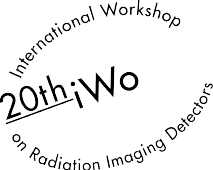Speaker
Description
Cross-linked fibrin based biomaterial allows one to design scaffolds with controlled stiffness, strength, and permeability for broad use in tissue engineering applications. To be able to assess their microstructural properties reliably, it is necessary to study the material’s internal structure on a volumetric basis and in high detail [1]. In this work, we demonstrate X-ray micro-CT imaging of the synthesized artificial tissue material.
We performed the micro-CT measurement of a fibrin bone scaffold using the in-house designed modular X-ray scanner TORATOM with the dual-source/dual-energy capability, consisting of two perpendicularly mounted imaging chains, each with one X-ray source/detector pair. In the presented study, we used two different types of X-ray imaging detectors to highlight influence of instrumentation on acquired results. The results from the large-area flat panel detector Perkin Elmer XRD1622 (pixel resolution 2048×2048 px, active area 410×410 mm, Gadox scintillator) were compared against data from large area device (LAD) composed of a matrix of 10 × 10 tiles of silicon pixel detectors Timepix (each of 256 × 256 pixels with pitch of 55 um) having fully sensitive area of 14.3 × 14.3 cm2 without any gaps between the tiles. Superior quality of the LAD for imaging of the low attenuation objects was demonstrated in [2].
The radiograms acquired during imaging of the specimen using either detector were used to develop detailed geometrical models of its microstructure. The morphological conformity between the investigated material and the reconstructed topographical data is presented for each considered detector type. We show that organic base material used for production of the relatively small investigated specimens yielding generally low achievable signal-to-noise ratio (SNR) in the radiograms. However, performance of the LAD was superior due to its sensitivity for low energy photons. Nevertheless, to obtain the highest achievable resolution using the LAD detector, it was necessary to introduce correction procedure to compensate drift of the tube focal spot due to relatively long total measurement time necessary to acquire whole CT data set together with relatively high geometrical magnification 34 x. Resultant reconstruction has 1 um voxel size (slight oversampling during tomographic reconstruction). Other corrections were necessary due to LAD imperfections: Edgeless Timepix detector used for LAD assembling has larger border pixels with different response than others; LAD detector is not fully flat. Besides of spot shift compensation and other post-processing corrections, most important improvement was reached thanks to slight tilting of the detector.
Acknowledgment
The research has been supported by the European Regional Development Fund in frame of the project Kompetenzzentrum MechanoBiologie (ATCZ133) in the Interreg V-A Austria - Czech Republic programme and project INAFYM (CZ.02.1.01/0.0/0.0/16_019/0000766).
References
1. D. Kytyr, P. Zlamal, P. Koudelka, T. Fila, N. Krcmarova, I. Kumpova, D. Vavrik, A. Gantar, S. Novak, Deformation analysis of gellan-gum based bone scaffold using on-the-fly tomography, Materials and Design 134 (2017) 400–417.
2. I. Kumpova , D. Vavrik, T. Fila, P. Koudelka, I. Jandejsek, J. Jakubek, D. Kytyr, P. Zlamal, M. Vopalensky, A. Gantar, High resolution micro-CT of low attenuating organic materials using large area photon-counting detector, J. Instrum. 11 (2016).
3. X. Llopart, M. Campbell, R. Dinapoli, D. San Segundo, E. Pernigotti, Medipix2: a 64-k pixel readout chip with 55lmsquare elements working in single photon counting mode, IEEE Trans. Nucl. Sci. 49 I (2002) 2279–2283, 2014.




